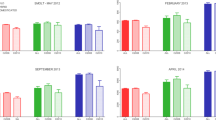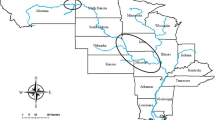Abstract
Animals often exhibit accelerated or “compensatory” growth (CG) after periods of environmentally induced growth depression, raising important questions about how they cope with environmental variability. We tested an underexplored hypothesis regarding the evolutionary consequences of CG; namely, that natural populations differ in CG responses. Common-garden experiments were used to compare subadult growth following food restriction between groups (control, treatment) of two Atlantic salmon (Salmo salar) populations and their first-generation (F1) hybrids. The populations are found at similar latitudes but characterized by differences in migration distance. We predicted that long-distance migrants would better maintain growth trajectories following food restriction than short-distance migrants because they: (1) require larger body sizes to offset energetic costs of migration and (2) face greater time constraints for growth as they must leave non-breeding areas earlier to return to breeding areas. Long-distance migrants grew faster, achieved quicker CG (relative to controls), and their overall body morphology was more streamlined (a trait known to improve swimming efficiency) than slower growing short-distance migrants. F1 hybrids were generally intermediate in “normal” growth, CG, and body morphology. We concluded that CG responses may differ considerably among populations and that the conditions generating them are likely interconnected with selection on a suite of other traits.




Similar content being viewed by others
References
Ali M, Nicieza A, Wootton RJ (2003) Compensatory growth in fishes: a response to growth depression. Fish Fish 4:147–190
Alveraz D, Nicieza AG (2005) Compensatory response “defends” energy levels but not growth trajectories in brown trout, Salmo trutta. Proc Roy Soc Lond Biol Sci B 272:601–607
Amiro PG (2003) Population status of inner Bay of Fundy Atlantic salmon (Salmo salar) to 1999. Can Tech Rep Fish Aquat Sci 2488:51
Arendt JD (1997) Adaptive intrinsic growth rates: an integration across taxa. Quart Rev Biol 72:149–177
Billerbeck JM, Lankford TE, Conover D (2001) Evolution of intrinsic growth and energy acquisition rates. Part I. Trade-offs with swimming performance in Menidia menidia. Evolution 55:1863–1872
Bilton HT, Alderdice DF, Schnute JT (1982) Influence of time and size at release of juvenile coho salmon (Oncorhynchus kisutch) on returns at maturity. Can J Fish Aquat Sci 39:426–442
Bookstein FL (1991) Morphometric tools for landmark data: geometry and biology. Cambridge University Press, New York
Both C, Visser ME (2001) Adjustment to climate change is constrained by arrival date in a long-distance migrant bird. Nature 411:296–298
Bradley MC, Perrin N, Calow P (1991) Energy allocation in the cladoceran Daphnia magna, under starvation and refeeding. Oecologia 86:414–418
Bull CD, Metcalfe NB, Mangel M (1996) Seasonal matching of foraging to anticipated energy requirements in anorexic juvenile salmon. Proc Roy Soc Lond Biol Sci B 263:13–18
Carlson SM, Hendry AP, Letcher BH (2004) Natural selection acting on body size, growth rate and compensatory growth: an empirical test in a wild trout population. Evol Ecol Res 6:955–973
COSEWIC (2006) COSEWIC assessment and update status report on Atlantic salmon (Salmo salar). Inner Bay of Fundy populations. Committee of the Status of Endangered Wildlife in Canada (COSEWIC), Ottawa
Crespi BJ, Teo R (2002) Comparative phylogenetic analysis of the evolution of semelparity and life history in salmonid fishes. Evolution 56:1008–1020
DFO (2002) Atlantic salmon maritimes provinces overview for 2002. Stock status report 2002/026, Department of Fisheries and Oceans (DFO), Ottawa
Dill LM, Ydenberg RC, Fraser AHG (1981) Food supply and territory size in juvenile coho salmon (Oncorhynchus kisutch). Can J Zool 59:1801–1809
Drent RJ, Fox AD, Stahl J (2006) Travelling to breed. J Ornithol 147:122–134
Elliott JM (1975) Weight of food and time required to satiate brown trout, Salmo trutta L. Freshw Biol 5:51–64
Frankham R, Ballou JD, Briscoe DA (2002) Introduction to conservation genetics. Cambridge University Press, Cambridge
Fraser DJ, Bernatchez L (2005) Adaptive migratory divergence among sympatric brook charr populations. Evolution 59:611–624
Fraser DJ, Jones MW, McParland TL, Hutchings JA (2007) Loss of historical immigration and the unsuccessful rehabilitation of extirpated salmon populations. Conserv Genet 8:527–546
Hawkins DK, Quinn TP (1996) Critical swimming velocity and associated morphology of juvenile coastal cutthroat trout (Oncorhynchus clarki clarki), steelhead trout (Oncorhynchus mykiss) and their hybrids. Can J Fish Aquat Sci 53:1487–1496
Herbinger CM, O’Reilly PT, Verspoor E (2006) Unravelling first-generation pedigrees in wild endangered salmon populations using molecular genetic markers. Mol Ecol 15:2261–2275
Holtby LB, Andersen BC, Kadowaki RK (1990) Importance of smolt size and early ocean growth to interannual variability in marine survival of coho salmon (Oncorhynchus kisutch). Can J Fish Aquat Sci 47:2181–2194
Hutchings JA (1994) Age-specific and size-specific costs of reproduction within populations of brook trout, Salvelinus fontinalis. Oikos 70:12–20
Jessop BM (1986) Atlantic salmon (Salmo salar) of the big salmon river, New Brunswick. Can Tech Rep Fish Aquat Sci 1415
Jobling M, Koskela J (1996) Interindividual variations in feeding and growth in rainbow trout during restricted feeding and in subsequent periods of compensatory growth. J Fish Biol 49:658–667
Johnnson JI, Bohlin T (2006) The cost of catching up: increased winter mortality following structural growth compensation in the wild. Proc Roy Soc Lond Biol Sci B 273:1281–1286
Jonsson B, Jonsson N (2006) Life-history effects of migratory costs in anadromous brown trout. J Fish Biol 69:860–869
King TL, Kalinowski ST, Schill WB, Spidle AP, Lubinski BA (2001) Population structure of Atlantic salmon (Salmo salar L.): a range-wide perspective from microsatellite DNA variation. Mol Ecol 10:807–821
Kinnison MT, Unwin MJ, Hendry AP, Quinn TP (2001) Migratory costs and the evolution of egg size and number in introduced and indigenous salmon populations. Evolution 55:1656–1667
Koskinen M, Haugen T, Primmer C (2002) Contemporary fisherian life-history evolution in small salmonid populations. Nature 419:826–830
Lacroix G, Knox D, Stokesbury MJW (2005) Survival and behaviour of post-smolt Atlantic salmon in coastal habitat with extreme tides. J Fish Biol 66:485–498
Letcher BH, Rice JA, Crowder LB (1996) Size-dependent effects of continuous and intermittent feeding on starvation time and mass loss in starving yellow perch larvae and juveniles. Trans Am Fish Soc 125:14–26
Mangel M, Munch SB (2005) A life-history perspective on short and long-term consequences of compensatory growth. Am Nat 166:E155–E176
Metcalfe NB, Monaghan P (2001) Compensation for a bad start: grow now, pay later? Trends Ecol Evol 166:254–260
Mills D (1989) Ecology and management of Atlantic salmon. Chapman & Hall, London
Nicieza AG, Reiriz GL, Brana F (1994) Variation in digestive performance between geographically disjunct populations of Atlantic salmon: countergradient in passage time and digestion rate. Oecologia 99:243–251
Nicieza AG, Metcalfe NB (1997) Growth compensation in juvenile Atlantic salmon: responses to depressed temperature and food availability. Ecology 78:2385–2400
Nilsson J (1992) Genetic parameters of growth and sexual maturity in Arctic char (Salvelinus alpinus). Aquaculture 106:9–19
Purchase CF, Brown JA (2001) Stock-specific changes in growth rates, food conversion efficiencies and energy allocation in response to temperature change in juvenile Atlantic cod. J Fish Biol 58:38–52
Quinton JC, Blake RW (1990) The effect of food cycling and ration level on the compensatory growth response in rainbow trout. J Fish Biol 37:33–41
Rohlf FJ (2003) Morphometrics at SUNY Stony Brook. http://life.bio.sunysb.edu/morph/. Cited 17th May 2007
Schultz ET, Lankford TE, Conover DO (2002) The covariance of routine and compensatory juvenile growth rates over a seasonality gradient in a coastal fish. Oecologia 133:501–509
Sibly RM, Calow P (1986) Physiological ecology of animals. Blackwell, Oxford
Taylor EB (1991) A review of local adaptation in Salmonidae, with particular reference to Pacific and Atlantic salmon. Aquaculture 98:185–207
Taylor EB, Foote CJ (1991) Critical swimming velocities of juvenile sockeye salmon and kokanee, the anadromous and non-anadromous forms of Oncorhynchus nerka (Walbaum). J Fish Biol 38:407–419
Waples RS (1990) Conservation genetics of Pacific salmon. II. Effective population size and the rate of loss of genetic variability. J Hered 81:267–276
Wilson PN, Osbourne DF (1960) Compensatory growth after undernutrition in mammals and birds. Biol Rev Camb Philos Soc 37:324–363
Yearsley JM, Kyriazakis I, Gordon IJ (2004) Delayed costs of growth and compensatory growth rates. Funct Ecol 18:563–570
Acknowledgments
We are grateful to workers at DFO’s Coldbrook Biodiversity Facility for providing the salmon gametes used in this study. We also thank workers at Dalhousie University’s Aquatron Facility for assistance during the experimental component of our study. Comments from A. Laurila, C. Purchase, D. Ruzzante and two anonymous reviewers greatly improved the quality of the paper. This work was funded by a Natural Sciences and Engineering Research Council of Canada (NSERC) Discovery Grant to JAH, a NSERC postdoctoral scholarship to DJF, and le Fonds Québécois de la Recherche sur la Nature et les Technologies and Canada Scholar NSERC scholarships to LKW. Experiments undertaken in this study comply with the requirements of the Canadian Council on Animal Care (CCAC).
Author information
Authors and Affiliations
Corresponding author
Additional information
Communicated by Anssi Laurila.
Rights and permissions
About this article
Cite this article
Fraser, D.J., Weir, L.K., Darwish, T.L. et al. Divergent compensatory growth responses within species: linked to contrasting migrations in salmon?. Oecologia 153, 543–553 (2007). https://doi.org/10.1007/s00442-007-0763-6
Received:
Accepted:
Published:
Issue Date:
DOI: https://doi.org/10.1007/s00442-007-0763-6




